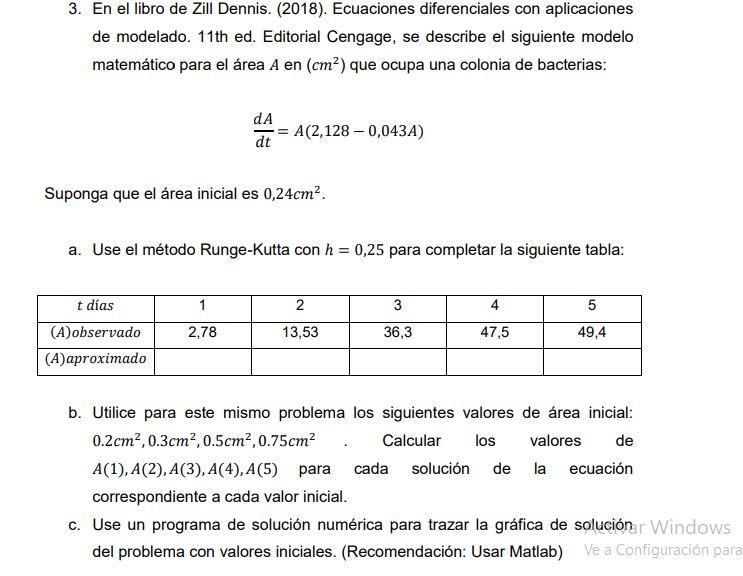¡Tu solución está lista!
Nuestra ayuda de expertos desglosó tu problema en una solución confiable y fácil de entender.
Mira la respuestaMira la respuesta done loadingPregunta: In Zill Dennis's book. (2018). Differential equations with modeling applications. 11th ed. Editorial Cengage, the following mathematical model is described for the area A in (cm²) that a colony of bacteria occupies: dA A(2.128 -0.0434) dt Suppose the initial area is 0.24cm². a. Use the Runge-Kutta method with h = 0.25 to complete the following table: t days
In Zill Dennis's book. (2018). Differential equations with modeling applications. 11th ed. Editorial Cengage, the following mathematical model is described for the area A in (cm²) that a colony of bacteria occupies: dA A(2.128 -0.0434) dt Suppose the initial area is 0.24cm². a. Use the Runge-Kutta method with h = 0.25 to complete the following table: t days 1 2 3 4 5 (A) observed 2.78 13.53 36.3 47.5 49.4 (A)approximate b. Use for this same problem the following initial area values: 0.2cm², 0.3cm², 0.5cm², 0.75cm² Calculate the values of A(1),A(2), A(3), A(4),A(5 ) ) for each solution of the equivalence to each initial value. C. Use a numerical solver to plot the Windows solution graph of the initial-value problem. (Recommendation: Use Matlab) Go to Settings for =
- Esta es la mejor manera de resolver el problema.Solución
Texto de la transcripción de la imagen:
3. En el libro de Zill Dennis. (2018). Ecuaciones diferenciales con aplicaciones de modelado. 11th ed. Editorial Cengage, se describe el siguiente modelo matemático para el área A en (cm²) que ocupa una colonia de bacterias: dA A(2,128 -0,0434) dt Suponga que el área inicial es 0,24cm². a. Use el método Runge-Kutta con h = 0,25 para completar la siguiente tabla: t días 1 2 3 4 5 (A) observado 2,78 13,53 36,3 47,5 49,4 (A)aproximado b. Utilice para este mismo problema los siguientes valores de área inicial: 0.2cm², 0.3cm², 0.5cm², 0.75cm² Calcular los valores de A(1),A(2), A(3), A(4),A(5) para cada solución de la ecuación correspondiente a cada valor inicial. c. Use un programa de solución numérica para trazar la gráfica de solucionar Windows del problema con valores iniciales. (Recomendación: Usar Matlab) Ve a Configuración para =

Estudia mejor, ¡ahora en español!
Entiende todos los problemas con explicaciones al instante y pasos fáciles de aprender de la mano de expertos reales.

